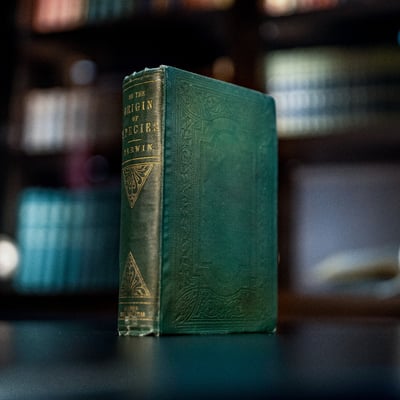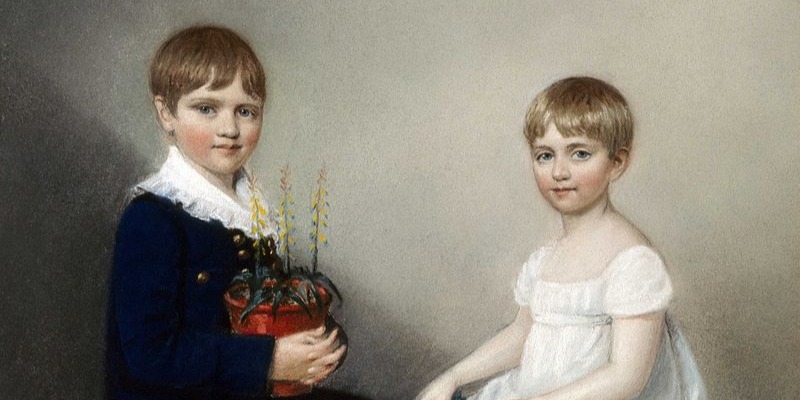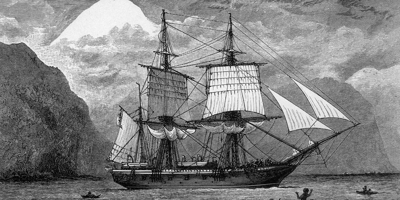The Story of Charles Darwin: Chapter IV Read Chapter III here. Sniffling, he steadied himself using...
The humble beginnings of Darwin, the Collector
The Story of Charles Darwin: Chapter I

A light rustle was enough to wake him. He instantly sat up, rubbing away any lingering signs of sleep from his eyes. The boy’s gaze narrowed on the patch of grass before him, where only a minute ago, there had been signs of movement. Then a second rustle came from further ahead. Heart pounding, he inched closer, taking care not to make any sudden movements. Mother had warned him about the snakes.
Slowly, he lowered his face into the dirt to peer at the curious little creature scuttling across the hard-packed earth. A beautiful specimen soon came into focus – round, with white and brown speckles, and a second- with a matching black and brown pattern, tailing closely behind. In a daze, he watched as they scampered along uneven crevices in the soil, and disappeared into the thicket, camouflaging with the roots of an elm tree. Unable to contain his excitement any longer, he ran to it and frantically tore back the bark. Spotting them underneath, he scooped them up in his pudgy little fists.
Suddenly, to his utmost surprise, a specimen unlike any he had seen before emerged from behind the clearing; sporting a distinct red streak, running down a metallic green bodice, and perfectly clipped wings. In ardent desperation to hold onto his previous finds and also acquire the third, he hastily tossed it in his mouth. Almost instantly, he cried out loud in alarm and spat it out- the little pest had defensively released a bodily fluid of some kind, leaving a rather acrid taste in his mouth.
As he trudged home, he consoled himself with the thought of the four new rocks, and two new beetles that would soon join his collection. Come tomorrow, he would be sure to return to look for the one that got away. “Once bitten, twice shy” was not a familiar concept to the budding collector.
A young Darwin’s distinct interests
A curious and investigative character till the end of his life, Charles Robert Darwin was a natural born collector. Fuelled by science books, backyard experiments with his brother, and hours of bird-watching, Darwin’s fascination with the natural world as a boy, incited in him an all-consuming desire to collect. At the age of 9, Darwin dedicated his time to assembling a plethora of varied and elaborate collections; stones, minerals, shells, coins, seals, franks, stuffed animals, and dried plant specimens. A particular category that specially intrigued the young collector however, was beetles, which he spared no expense to acquire more of; he was known to have even popped these in his mouth for safekeeping. To procure such samples, Darwin would frequently enjoy taking lone strolls and exploring expanses of fields and woodlands.
These obsessive collecting habits prompted Darwin to make a number of observations, and planted several questions and theories in his mind about the nature and design of the living kingdom and its inhabitants. Although disinterested in school and his studies, Darwin took a liking to certain subjects that enabled him to obtain answers to some of his questions, and test theories. As a result, chemistry, biology and botany were enticing forms of study that further tended to his preoccupation with living species.

Dad’s disapproval
Darwin’s family had a very different outlook when it came to his passions. Displeased with the nature of his interests, his physician father persuaded him to take academia more seriously. At the mere age of 16, Darwin was enrolled at the University of Edinburgh to study medicine.
Such was the nature of his passion however, that despite assenting to his father’s wishes, Darwin was keen to attend other lectures on broader natural sciences during his time at Edinburgh. Among these were lectures conducted by Robert Jameson, a Scottish mineralogist, and professor of natural history. Although Darwin claimed to find Jameson’s manner of lecturing incredibly dull, compilations of Darwin’s notes exhibit his heavy annotation of Jameson’s books. He also attended Jameson’s Natural History Association events, where he was enthralled by demonstrations of specific techniques to effectively document the natural positions and behaviours of birds. During his time at Edinburgh, Darwin was also exposed to other topics of study within the field, in the form of debates between intellectuals that he encountered at university.
In time, Darwin also learned that he was not cut out for medicine; the passionate naturalist could not stand the thought or sight of animal dissection or other anatomical and medical practices, and did not attend many classes. Although Darwin’s father’s endeavours to produce another doctor in the family were ultimately futile, they proved to be a turning point for his interests, and his collections. Cementing his interest in the natural world, the University of Edinburgh saw the rise of Darwin, the geologist.

Theology, and geology at Cambridge
Darwin’s father made a second attempt to influence his academic life, which took the shape of coercion to study theology at Cambridge university. While Darwin’s appreciation for theology as a practical explanation of the natural world grew, his interest in studies did not. It would seem that Darwin could not escape his eventual destiny of becoming an established naturalist, as this change in the course of his life did little to steer him from natural sciences.
The environment at Cambridge was conducive to Darwin’s sense of curiosity, being that it was filled with a number of other like-minded peers who observed and questioned everything around them. At Cambridge, he befriended William Whewell, an amateur mineralogist, with whose help he continued to study and build his mineral collection. He also attended a handful of lectures taught by Adam Sedgwick, the founder of modern geology, a professor at the university. The relationship between the two flourished when Darwin accompanied the academic on a trip to Wales to inspect fossil-bearing rocks. Darwin spoke of the experience as ‘setting him up wonderfully’ before his Beagle voyage, as it imparted him with a better understanding of the field work that geology entailed. Sedgwick also introduced prominent principles of philosophy to Darwin, and broadened his scope of thought, compelling him to look at life in a different light.
A lucky break
It was also at Cambridge that he met the man who became the reason he was able to journey around the world. A professor of botany, John Henslow took Darwin under his wing, and helped nurture his interests, teaching him how to make systematic scientific observations and helping him blossom into a naturalist. Henslow also introduced Darwin to Alexander von Humboldt’s work, which detailed his travels and discoveries to the ‘New World’. Darwin himself credited Humboldt’s literature for reigniting his interest in geology, which had been presumably diluted by the drab droning of lecturers at Edinburgh.
Most notable of his contributions to Darwin’s life however, was his invitation to Darwin to set sail as a member of the HMS Beagle’s crew and a naturalist, in 1831. Recognising the power of Darwin’s passions and potential, Henslow recommended him to the ship’s captain as an excellent choice for a companion.
The worst of it was done. Expectant of father’s usual scorn and displeasure at his broaching the topic, Darwin stood in front of him and timidly mumbled his proposal to board the ship, seldom making eye contact. Much to his surprise, Father eventually agreed to take on the expense- but not before he had thoroughly voiced his opinions on the matter, using phrases like ‘a colossal waste of time’.
A bright eyed and bushy-tailed Darwin quickly wolfed down dinner, and ran upstairs, excited to pack his bags. Later that night, when he went to bed, his head was spinning with thoughts and dreams of what a new day would bring.
The idiom goes, 'don't judge a book by its cover'.
We wanted to take a closer look at who the man behind the theory of evolution really was, before his career successes. To do this, we read a number of extensive articles, and journals, some of which are listed below. But it wasn't enough. And so came our trip to Cambridge, where Darwin spent a good number of years, before taking on the role of a naturalist. Museums, and exhibitions at the University of Cambridge not only revealed his several quirks and habits, but also left us feeling inspired. Read on to see what this interest and inspiration culminated into, and what more we discovered about Darwin.
Read Chapter II here.

Showpiece has made it possible to own the book that changed the world. Find out more about our £275,000 first edition ‘On the Origin of Species’, and its incredible journey over 163 years. Available now from £50, find out more.
Research resources:
https://www.amnh.org/exhibitions/darwin/young-naturalist
https://www.amnh.org/exhibitions/darwin/young-naturalist/a-lifelong-passion#:~:text=Darwin%20experienced%20one%20such%20defense,right%20hand%20into%20my%20mouth.
https://www.thetimes.co.uk/article/ah-the-joys-of-having-a-beetle-in-your-mouth-l9kwxhcntvg
https://darwin200.christs.cam.ac.uk/childhood
https://www.ed.ac.uk/alumni/services/notable-alumni/alumni-in-history/charles-darwin
https://www.darwinproject.ac.uk/adam-sedgwick
https://www.darwinproject.ac.uk/john-stevens-henslow
https://www.darwinproject.ac.uk/commentary/geology/darwin-glen-roy
https://www.darwinproject.ac.uk/commentary/voyage-hms-beagle





